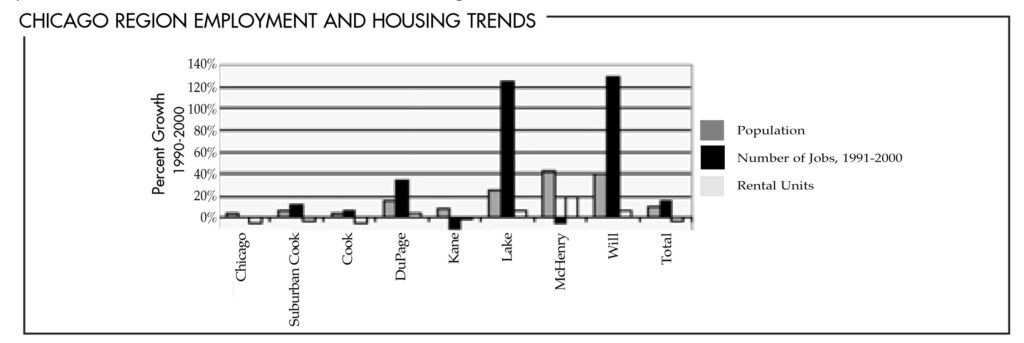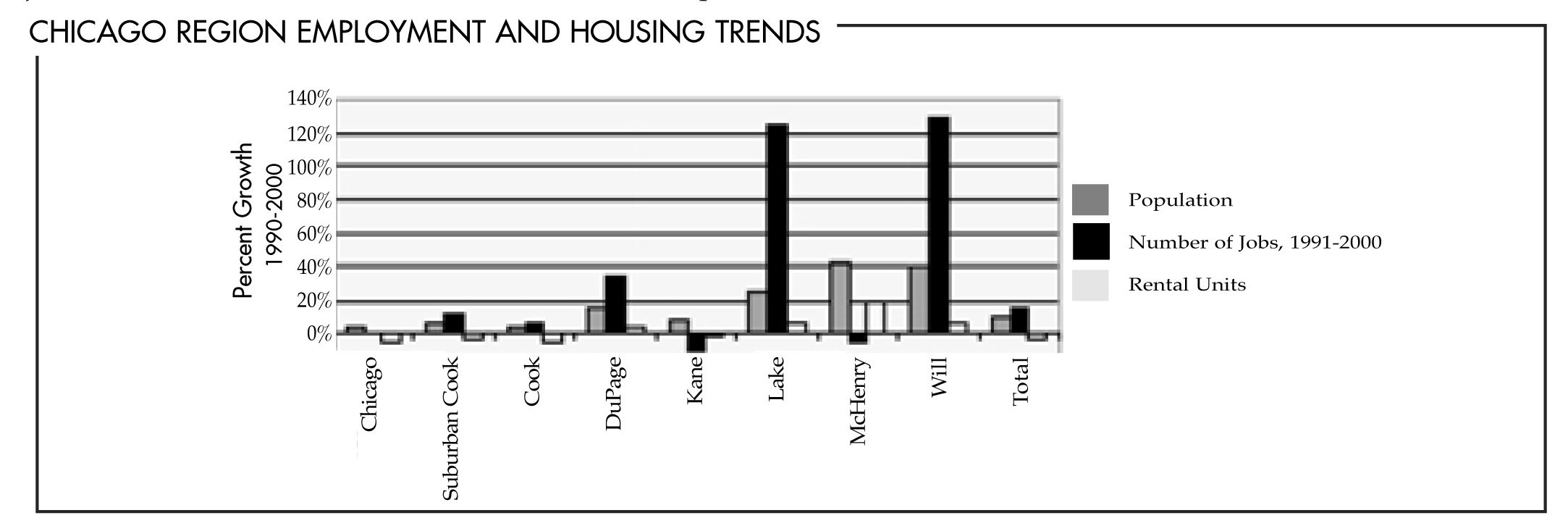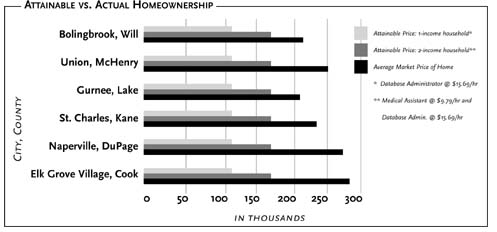Accommodating the Housing Needs of Families and Workers as the Chicago Region and Illinois Grow

CHALLENGES
According to the 2000 census, the six-county Chicago region grew by 11 percent in population and 16 percent in jobs in the last decade, but lost more than 28,000 apartments.

Illinois experienced a similar discrepancy: population increased by nearly nine percent, jobs by nearly 14 percent, but again the rental housing stock shrunk by two percent.
Despite local and state efforts to overcome segregation and invest in a competitive workforce, these trends are particularly severe in high job-growth areas and revitalizing neighborhoods, where homeownership is out of reach for entry-level workers. For example, according to a 2003 study by the Center for Regional Employment Strategies, 75 percent of households living within five miles of job centers in the Chicago region are non-Hispanic white, compared with a 57 percent overall non-Hispanic white population.
Rental vacancy rates within five miles of job centers are also 28 percent tighter than in the Chicago region at large, the study found, and median rental rates are $100 per month higher. According to the National Low Income Housing Coalition, an employee earning minimum wage would have to work 120 hours per week in order to afford a market-rate, two-bedroom apartment in Illinois.

DIVERSITY OF RENTERS
These numbers illustrate both how difficult it is for many workers to find attainable housing near their jobs, and how removed many jobs are from housing and transportation. It is no wonder that traffic congestion in the Chicago region ranks third worse in the nation at a cost of more than $4 billion a year or almost $1,000 per rush hour commuter according to Texas Transportation Institute. Statewide, in the last decade, there has been a 12 percent increase in the number of people driving alone to work, and a 14 percent decrease in the percent of people using public transit.
Since 1990, homeowners are spending a greater percentage of their incomes on housing, while renters are paying a slightly smaller percentage.

Despite encouraging trends in cost burden for renters, people with very low incomes are still struggling: nearly 900,000 Illinois households earn less than $20,000 per year, but only 554,000 households are paying housing costs considered affordable to households at this income. In the state of Illinois, there has been a 66 percent increase in the number of households living in severely overcrowded situations.
Complicating Illinois’ ability to tackle these challenges is the fact that typical supply and demand models are not functioning normally. Market Analyst Tracy Cross analyzed housing permits issued from 1990 to 2000, and found that compared to other metropolitan areas, the Chicago region rental market has under produced:only three percent of all housing permits issued in metropolitan Chicago in the last decade have been for multi-family housing (for rent or sale). This compares to 22 percent nationwide. Non-economic barriers interfering with the market’s ability to meet local demand include everything from community resistance to the fact that each of the region’s 274 municipalities has a different approach to addressing housing needs.
OPPORTUNITIES
Absent a state housing policy to guide them, but inspired in part by the voices of employers investing in housing options, the Metropolitan Mayors Caucus partnered with MPC to form a housing task force. The Caucus adopted a Housing Action Agenda and Housing Endorsement Criteria that spell out how housing for a growing workforce — housing affordable to local workers at a broad range of incomes that is well managed, well designed, and located near jobs and transit — can be a community asset. The Housing Task Force continues to provide an effective forum for shared learning and constructive dialogue about key housing issues for municipal leaders.
In January of 2005, the State of Illinois released “Building for Success: Illinois ’ Comprehensive Housing Plan ,” the first housing plan of its kind for the state. Based on Gov. Rod Blagojevich’s Executive Order , which outlined his housing policy and priorities and appointed a Task Force to transform these policies into a Plan, Building for Success provides a multi-year agenda for the promotion of affordability and choice, the creation and preservation of the state’s supply of affordable and workforce housing, and the engagement of local and state leaders in advancing housing solutions for all Illinois families. The State Housing Task Force, chaired by Illinois Housing Development Authority Executive Director Kelly King Dibble.
Now, both the Illinois House or Representatives and the State Senate have Committees dedicated to advancing good housing policy. Since 2002, this Administration has signed into law several housing bills, including the Housing Opportunity Tax Incentive, the Affordable Housing and Planning Appeals Act, the Rental Housing Support Bill, and the extension of the Housing Donation Tax Credit. Now Mayors, housing professionals, and business leaders are beginning to act on these changes and informing the work of the governor’s new Task Force.
Whether one’s primary concern is health care or education, traffic gridlock or open space, welfare reform or workforce competitiveness, Illinois ‘ ability to tackle these issues depends on the availability of a range of quality housing options near jobs and transit throughout the state.
All data from the 2000 Census, except where noted.